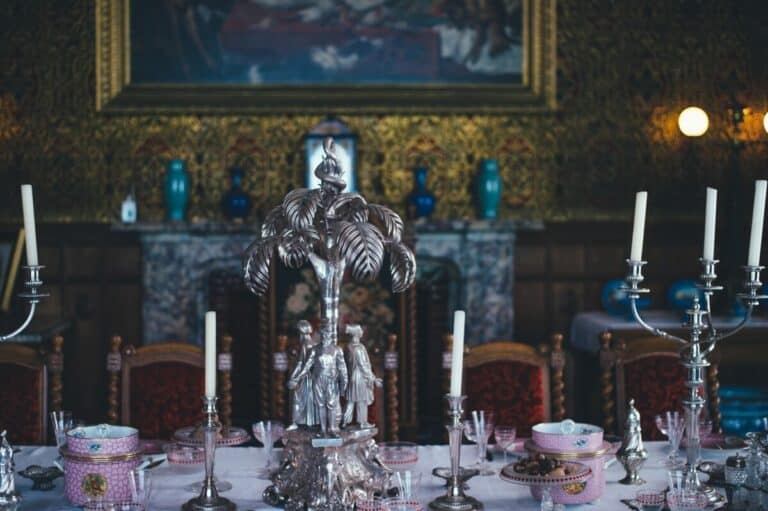Have you inherited family heirlooms and are curious to know what your antique Antique Victorian Silver Teapot is worth? There was a time not too long ago when a silver or silver-plated wedding gift was a highly prized piece. Wealthier people would buy high-quality silverware consisting of tea sets, cutlery or simply serving trays.
Unfortunately, today nobody likes to rub clean these pieces of silverware anymore. It was one of the little pleasures of another era, now obsolete simply because of lack of time. And with the rise of affordable cutlery and changing fashions, silverware tends to gather dust in drawers. And what’s the point of cluttering up your kitchen with items that you only bring out once a year for the holidays, when you can get a relatively good price for antique silver?
If you’re wondering what your silver is worth, and where you can sell your silver at a good price, we have some helpful suggestions for you.
7 criteria to determine the value of your antique silver
When it comes to determining the value of your silverware and antique silver objects, there are several elements to take into account. These same criteria are used in the valuation of antique furniture and family heirlooms.
As a general rule, silver pieces of considerable value should have certain characteristics: the objects should be in their original condition with wear marks in the normal places, the weight of the object, the craftsmanship, the provenance, the age, and the rarity will also be taken into consideration during an evaluation. Among the most sought-after marks are “Hanau” silver from Germany and “Barnard” silver from London.
Craftsmanship, design and style
One of the primary criteria for determining the value of antique silver objects is craftsmanship, that is, the quality of its execution.
If we take the example of an 18th-century silver teapot made by Master Jan Dronrijp of Groningen, we need to know the stages of its manufacture to understand the importance of the work it required. A silver ingot was hammered to form an irregular silver sheet. Again hammered and heated, it was worked into the shape of a teapot and then perfected by embossing, which is still done by hammering. The different parts of the teapot were then welded together using different silver alloys. This work required considerable time and effort, which are signs of quality. Such an antique teapot is absolutely not comparable to a teapot made in a factory by a machine.
Furthermore, size is not everything when it comes to the value of antique silver objects. A small snuff box or saltbox can fetch high prices if the workmanship is very complex. Larger, heavier objects will be worth less if their style or design is not interesting, and the quality of the work is poor.
The condition
It is extremely important and price-sensitive, that the item is in its original condition. The most desirable silver objects are those that are undamaged and unrepaired. When they are altered or when they are a combination of different pieces, a “marriage”, their value is much less. Silver objects that are personalized by engraving are generally worth less unless the engraving is of high quality, or it helps to identify the provenance of the object, such as family arms. A rare piece in poor condition can have great value when it is restored to its former glory.
Age and rarity
The age of an antique silver object can be a determining factor in its value, but rarity is usually a more important criterion. Some items are still easy to find, and therefore less desirable to collectors, while others are rare, and therefore valuable.
Provenance
A good provenance i.e. documented proof of ownership and origin of an object increases its value. In 1733, Thomas Germain (1673-1748), goldsmith to the king, made an impressive silver tureen for Louis XV. It was part of the collection of George Ortiz and was sold in 1996 for the record price of 8 million euros.
The silversmith
The silversmith who made the object is extremely important in determining its value. The most renowned silversmiths, whose work is a sign of high quality, are sought after by collectors and their creations reach very high prices. For example, Barnard, a famous London silversmith, made this silver bowl with two handles, which sold in our 2017 British and Irish Silver Sale for €4,099.
The hallmarks
Silver had had the same role as money in history. Ideal for making coins because it is quite expensive, silver is strong when alloyed with another metal such as copper, and silver coins can be produced in large quantities with standard size and weight. The purity of silver had to be standardized, and in the late Middle Ages hallmarks were introduced to guarantee the purity of the silver, and to identify the silversmith.
Over time, hallmarking systems evolved, with each country or region having its own hallmarks for silver. The hallmarks are also used to identify an object. These marks or parts of them are used: as a standard of guarantee of the purity of the silver, as a city mark, which reveals the location of the office in charge of the evaluation of the silver, as a date or as the mark of a particular silversmith.
Beware of forged hallmarks, however. They can be done well enough to make a recent coin look old! These marks are different from those frequently used in the late 19th and early 20th centuries. Indeed, antique silver objects were in high demand during this period, but there were not enough of them to satisfy the demand. Therefore, many silver objects were produced in the antique style, for example in Hanau, Germany, with marks that looked authentic, but were nevertheless slightly different. Hanau silver is highly sought after but beware of misleading marks. There may also be silver-plated objects with marks that look like silver hallmarks, or silver objects that have no marks. This is often the case with Indian or religious silver.
The weight of silver
Finally, the weight of silver is important in determining its intrinsic value. The weight can be a good indicator of the value of the silver used. In the past, silver objects were often melted down in times of war to be used as currency. A famous example is of course the silver furniture ordered in 1664 for Versailles by Louis XIV. Completed in 1682, it was sacrificed in 1689 for the war. Many objects have been lost over time, but it is also thanks to this that others have been created. Nowadays, silver objects are still melted down for money, but as a rule, an antique silver object is worth more than the intrinsic value of the metal it represents.
How to determine the value of your antique silver
When looking at a silver item, there are a few quick tips you can do on the spot that can help you tell if the item is genuine silver. Like the scratch test, the magnet test, or the ice-cube test.
But when you don’t know enough about silver, the best way to proceed is usually to contact experts in the field. There are specialized stores that offer free expertise before buying any silver object. The advantage of going through professionals to sell your silverware is that you benefit from free expertise, without any commitment to sell on your part. On the other hand, having your silverware appraised in a store implies bringing your object(s) with you.
Fortunately, there is an alternative, which consists in using an online appraisal service such as JustAnswer, whose antique experts are available around the clock for online and phone consultations. Feedback is specialized too. You can start using the service by simply typing your question in the interactive chat below:
How will your silver be valued by an expert in silver buy-back
Unlike a smelter, a broker, or a precious metal wholesaler – who only buy silver for the sole purpose of being recast, a silver appraiser will appraise your silver not only for its silver content but also on a variety of other criteria such as craftsmanship, design and style, age and condition, rarity, the silversmith and market demand. All of these elements play a role in determining the value of your silver piece.
How much can you earn?
The price of precious metals is on the rise again, and it’s not just gold that’s going up. Silver too is increasing. Antique silver is one of the tangible assets in which people interested in investing in art like to put their savings. But selling your silver will only be worth it if the metal is as pure as possible, and there’s nothing like an appraisal to know the price of a possible buy-back. Beware: some pieces of silverware will be worth more at auction, such as a Christofle dinner service, than by weight.
Silver Historical Prices Chart
The value of silver moves up and down over time. As already mentioned in this article, the value of an antique made of silver is higher than the intrinsic value of the metal. This is because it has additional characteristics that give it extra value (like the craftsmanship, the provenance, the age, and the rarity). For information purposes, we have decided to add a graph showing the evolution of the price of silver over time. This data can help you to get an idea of the minimum price (value by weight) you can get for your silver objects.
The value of silver flatware
The value of silver flatware will depend on the alloy and the weight offered for sale. There are basically four different types of silver: Pure Silver, 925 Sterling silver, 975 Sterling Silver, Plated Silver. The price per gram will change with the purity of the metal. Thus, if a hallmark 800 will be paid 29 cents, a hallmark 999, 99.99% pure will be negotiated 34 cents per gram. For plated cutlery, the price drops to 13 euros per kilo (and still, from 500 kg) and for plated knives to 3.34 euros per kilo.
Is plated silver worth anything? A lot of cutlery from our grandmothers’ bridal trousseau is not made of real silver but of plated silver. That doesn’t mean it has to go in the trash.
A final word to recap
A genuine antique silver object is normally hallmarked and should match the style and manner of the silversmith who made it. Silversmiths often specialized in a certain type of object. Silver objects should be in their original condition, with wear marks in normal places. Good provenance is preferable and should match the aspects of the object.
You can now determine the value of your items with these tips before perhaps contacting an expert who can give you a more accurate estimate of their value. We generally recommend using JustAnswer’s 24/7 online appraisal service which offers consultation at a very attractive price. And if you wish to sell any of your silver pieces, there are many distribution channels such as online marketplaces like Rubylane or Catawiki, as well as auctions.
Photo by Annie Spratt on Unsplash



